Abstract
Although it has been hypothesized that the synteny between mouse and human genes provides an approach to the localization of genes that determine quantitative traits in humans, this has yet to be demonstrated. We tested this approach with two quantitative traits, plasma apolipoprotein A-II (apoAII) and free fatty acid (FFA) levels. ApoAII is the second most abundant protein of high density lipoprotein particles, but its function remains largely unknown. We now show that, in a backcross between strains Mus spretus and C57BL/6J, apoAII levels correlate with plasma FFA concentrations on both chow (P < 0.0001) and high-fat (P < 0.0003) diets and that apoAII levels are linked to the apoAII gene (P < 0.0002). To test whether variations of the apoAII gene influence plasma lipid metabolism in humans, we studied 306 individuals in 25 families enriched for coronary artery disease. The segregation of the apoAII gene was followed by using an informative simple sequence repeat in the second intron of the gene and two nearby genetic markers. Robust sib-pair linkage analysis was performed on members of these families using the SAGE linkage programs. The results suggest linkage between the human apoAII gene and a gene controlling plasma apoAII levels (P = 0.03). Plasma apoAII levels were also significantly correlated with plasma FFA levels (P = 0.007). Moreover, the apoAII gene exhibited linkage with a gene controlling FFA levels (P = 0.003). Evidence for nonrandom segregation was seen with markers as far as 6-12 centimorgans from the apoAII structural locus. These data provide evidence, in two species, that the apoAII gene is linked to a gene that controls plasma apoAII levels and that apoAII influences, by an unknown mechanism, plasma FFA levels. The results illustrate the utility of animal studies for analysis of complex traits.
Full text
PDF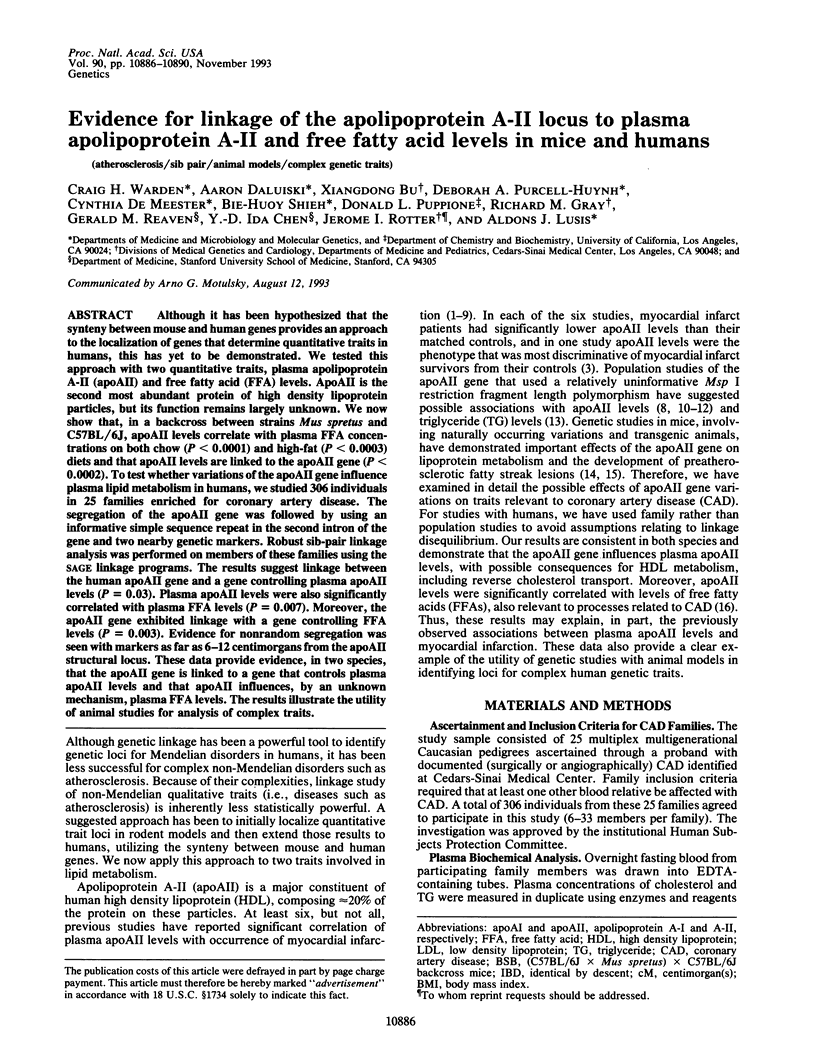
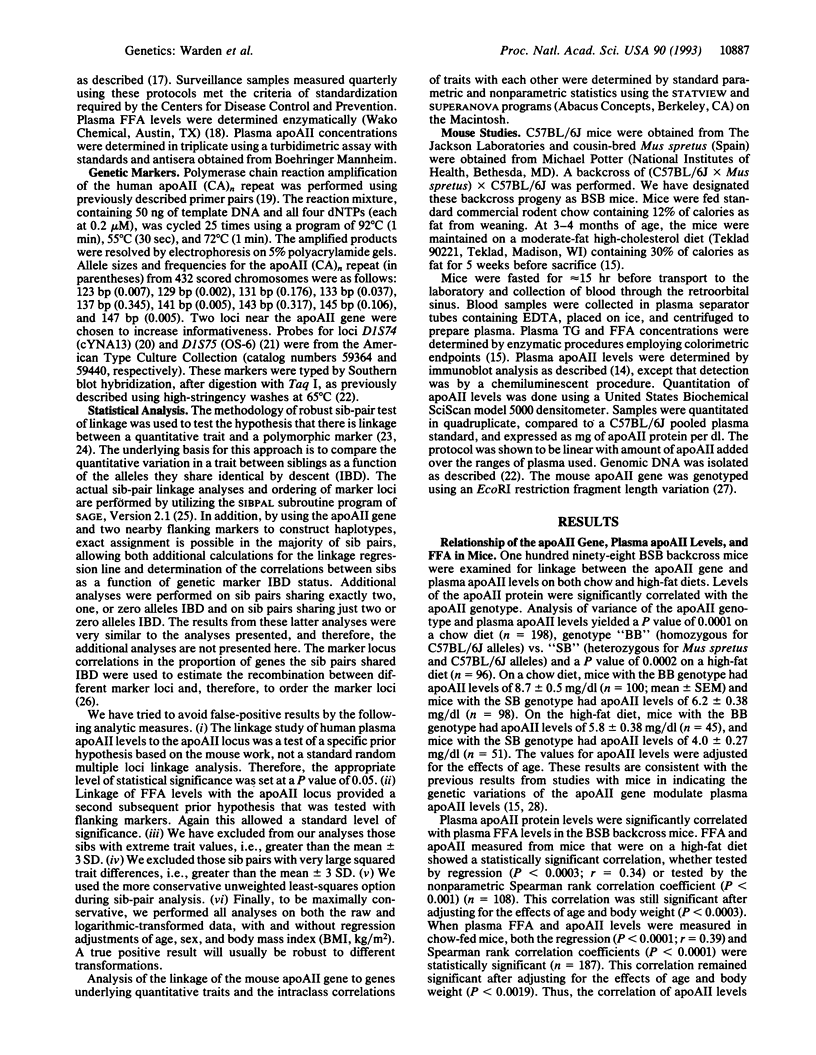
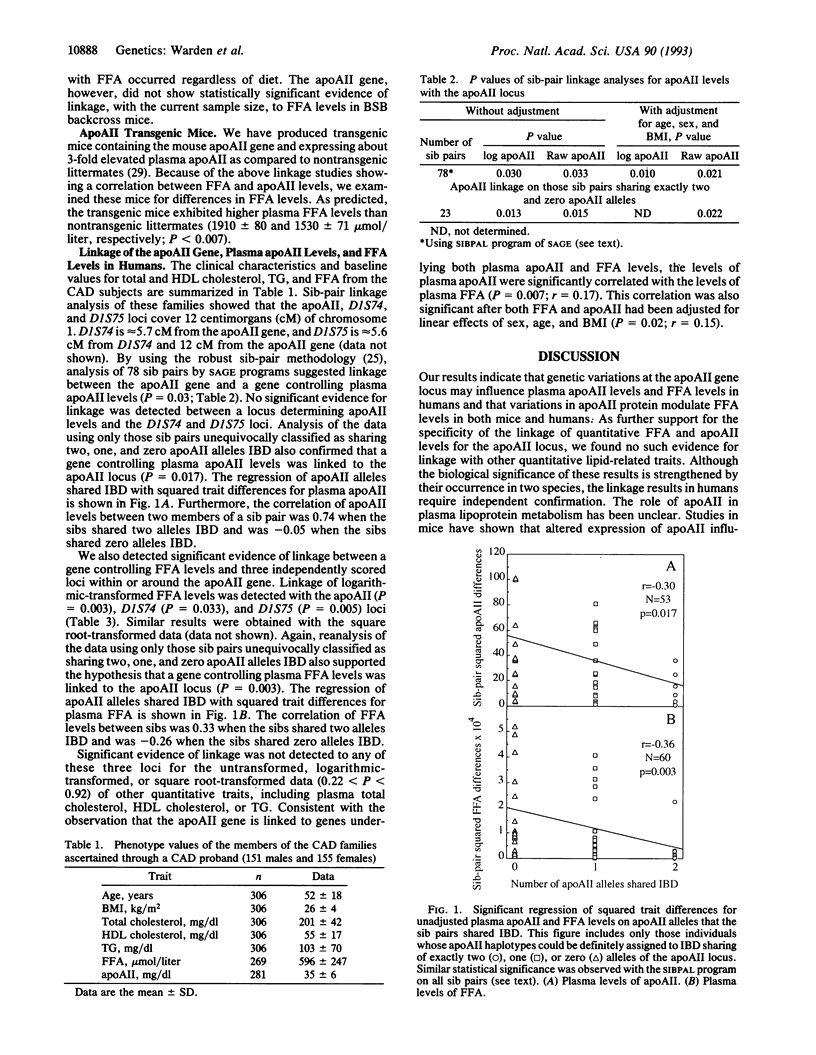
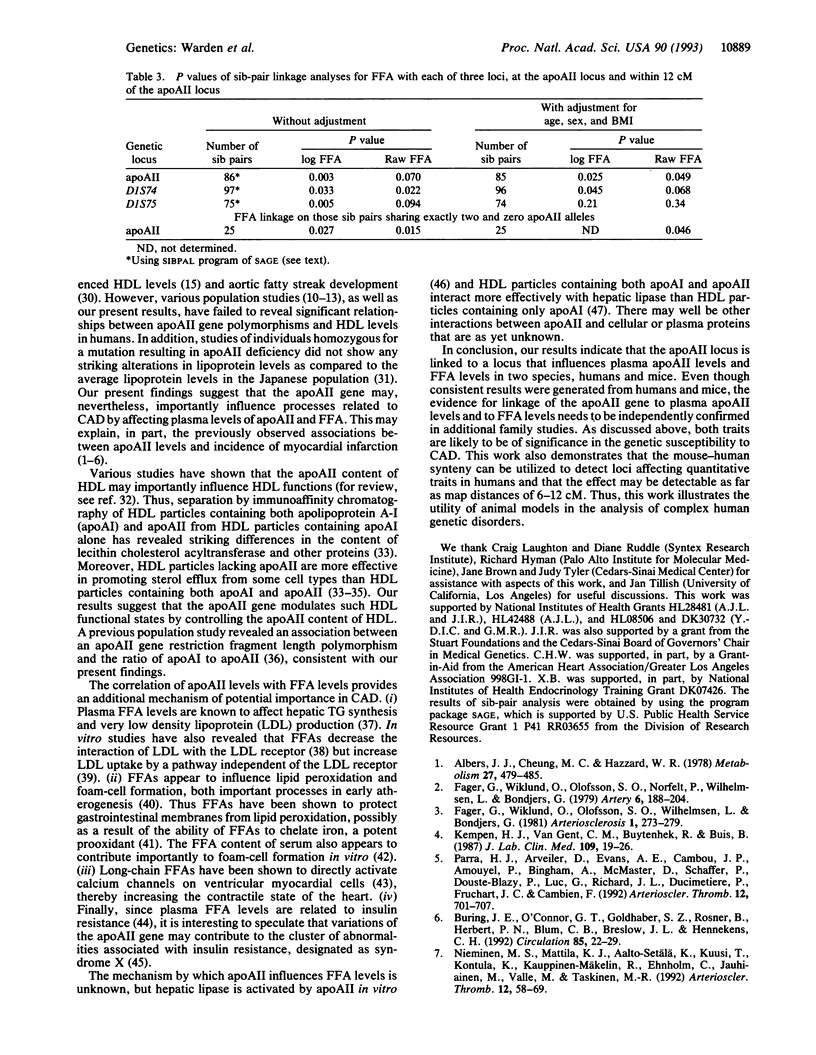
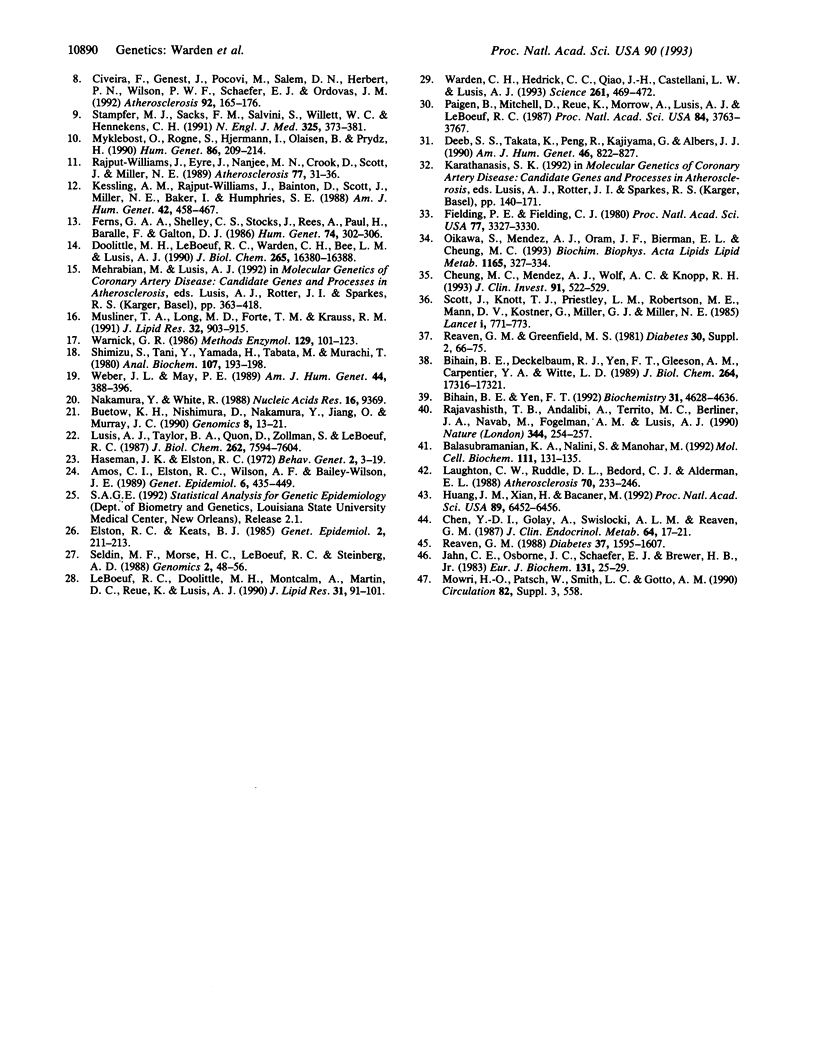
Selected References
These references are in PubMed. This may not be the complete list of references from this article.
- Albers J. J., Cheung M. C., Hazzard W. R. High-density lipoproteins in myocardial infarction survivors. Metabolism. 1978 Apr;27(4):479–485. doi: 10.1016/0026-0495(78)90102-6. [DOI] [PubMed] [Google Scholar]
- Amos C. I., Elston R. C., Wilson A. F., Bailey-Wilson J. E. A more powerful robust sib-pair test of linkage for quantitative traits. Genet Epidemiol. 1989;6(3):435–449. doi: 10.1002/gepi.1370060306. [DOI] [PubMed] [Google Scholar]
- Balasubramanian K. A., Nalini S., Manohar M. Nonesterified fatty acids and lipid peroxidation. Mol Cell Biochem. 1992 Apr;111(1-2):131–135. doi: 10.1007/BF00229584. [DOI] [PubMed] [Google Scholar]
- Bihain B. E., Deckelbaum R. J., Yen F. T., Gleeson A. M., Carpentier Y. A., Witte L. D. Unesterified fatty acids inhibit the binding of low density lipoproteins to the human fibroblast low density lipoprotein receptor. J Biol Chem. 1989 Oct 15;264(29):17316–17321. [PubMed] [Google Scholar]
- Bihain B. E., Yen F. T. Free fatty acids activate a high-affinity saturable pathway for degradation of low-density lipoproteins in fibroblasts from a subject homozygous for familial hypercholesterolemia. Biochemistry. 1992 May 19;31(19):4628–4636. doi: 10.1021/bi00134a013. [DOI] [PubMed] [Google Scholar]
- Buetow K. H., Nishimura D., Nakamura Y., Jiang O., Murray J. C. A detailed multipoint gene map of chromosome 1q. Genomics. 1990 Sep;8(1):13–21. doi: 10.1016/0888-7543(90)90220-o. [DOI] [PubMed] [Google Scholar]
- Buring J. E., O'Connor G. T., Goldhaber S. Z., Rosner B., Herbert P. N., Blum C. B., Breslow J. L., Hennekens C. H. Decreased HDL2 and HDL3 cholesterol, Apo A-I and Apo A-II, and increased risk of myocardial infarction. Circulation. 1992 Jan;85(1):22–29. doi: 10.1161/01.cir.85.1.22. [DOI] [PubMed] [Google Scholar]
- Chen Y. D., Golay A., Swislocki A. L., Reaven G. M. Resistance to insulin suppression of plasma free fatty acid concentrations and insulin stimulation of glucose uptake in noninsulin-dependent diabetes mellitus. J Clin Endocrinol Metab. 1987 Jan;64(1):17–21. doi: 10.1210/jcem-64-1-17. [DOI] [PubMed] [Google Scholar]
- Cheung M. C., Mendez A. J., Wolf A. C., Knopp R. H. Characterization of apolipoprotein A-I- and A-II-containing lipoproteins in a new case of high density lipoprotein deficiency resembling Tangier disease and their effects on intracellular cholesterol efflux. J Clin Invest. 1993 Feb;91(2):522–529. doi: 10.1172/JCI116231. [DOI] [PMC free article] [PubMed] [Google Scholar]
- Civeira F., Genest J., Pocovi M., Salem D. N., Herbert P. N., Wilson P. W., Schaefer E. J., Ordovas J. M. The MspI restriction fragment length polymorphism 3' to the apolipoprotein A-II gene: relationships with lipids, apolipoproteins, and premature coronary artery disease. Atherosclerosis. 1992 Feb;92(2-3):165–176. doi: 10.1016/0021-9150(92)90275-l. [DOI] [PubMed] [Google Scholar]
- Deeb S. S., Takata K., Peng R. L., Kajiyama G., Albers J. J. A splice-junction mutation responsible for familial apolipoprotein A-II deficiency. Am J Hum Genet. 1990 Apr;46(4):822–827. [PMC free article] [PubMed] [Google Scholar]
- Doolittle M. H., LeBoeuf R. C., Warden C. H., Bee L. M., Lusis A. J. A polymorphism affecting apolipoprotein A-II translational efficiency determines high density lipoprotein size and composition. J Biol Chem. 1990 Sep 25;265(27):16380–16388. [PubMed] [Google Scholar]
- Fager G., Wiklund O., Olofsson S. O., Wilhelmsen L., Bondjers G. Multivariate analyses of serum apolipoproteins and risk factors in relation to acute myocardial infarction. Arteriosclerosis. 1981 Jul-Aug;1(4):273–279. doi: 10.1161/01.atv.1.4.273. [DOI] [PubMed] [Google Scholar]
- Ferns G. A., Shelley C. S., Stocks J., Rees A., Paul H., Baralle F., Galton D. J. A DNA polymorphism of the apoprotein AII gene in hypertriglyceridaemia. Hum Genet. 1986 Nov;74(3):302–306. doi: 10.1007/BF00282553. [DOI] [PubMed] [Google Scholar]
- Fielding P. E., Fielding C. J. A cholesteryl ester transfer complex in human plasma. Proc Natl Acad Sci U S A. 1980 Jun;77(6):3327–3330. doi: 10.1073/pnas.77.6.3327. [DOI] [PMC free article] [PubMed] [Google Scholar]
- Haseman J. K., Elston R. C. The investigation of linkage between a quantitative trait and a marker locus. Behav Genet. 1972 Mar;2(1):3–19. doi: 10.1007/BF01066731. [DOI] [PubMed] [Google Scholar]
- Huang J. M., Xian H., Bacaner M. Long-chain fatty acids activate calcium channels in ventricular myocytes. Proc Natl Acad Sci U S A. 1992 Jul 15;89(14):6452–6456. doi: 10.1073/pnas.89.14.6452. [DOI] [PMC free article] [PubMed] [Google Scholar]
- Jahn C. E., Osborne J. C., Jr, Schaefer E. J., Brewer H. B., Jr Activation of the enzymic activity of hepatic lipase by apolipoprotein A-II. Characterization of a major component of high density lipoprotein as the activating plasma component in vitro. Eur J Biochem. 1983 Mar 1;131(1):25–29. doi: 10.1111/j.1432-1033.1983.tb07227.x. [DOI] [PubMed] [Google Scholar]
- Kempen H. J., van Gent C. M., Buytenhek R., Buis B. Association of cholesterol concentrations in low-density lipoprotein, high-density lipoprotein, and high-density lipoprotein subfractions, and of apolipoproteins AI and AII, with coronary stenosis and left ventricular function. J Lab Clin Med. 1987 Jan;109(1):19–26. [PubMed] [Google Scholar]
- Kessling A. M., Rajput-Wiliams J., Bainton D., Scott J., Miller N. E., Baker I., Humphries S. E. DNA polymorphisms of the apolipoprotein AII and AI-CIII-AIV genes: a study in men selected for differences in high-density-lipoprotein cholesterol concentration. Am J Hum Genet. 1988 Mar;42(3):458–467. [PMC free article] [PubMed] [Google Scholar]
- Laughton C. W., Ruddle D. L., Bedord C. J., Alderman E. L. Sera containing elevated nonesterified fatty acids from patients with angiographically documented coronary atherosclerosis cause marked lipid accumulation in cultured human arterial smooth muscle-derived cells. Atherosclerosis. 1988 Apr;70(3):233–246. doi: 10.1016/0021-9150(88)90174-8. [DOI] [PubMed] [Google Scholar]
- LeBoeuf R. C., Doolittle M. H., Montcalm A., Martin D. C., Reue K., Lusis A. J. Phenotypic characterization of the Ath-1 gene controlling high density lipoprotein levels and susceptibility to atherosclerosis. J Lipid Res. 1990 Jan;31(1):91–101. [PubMed] [Google Scholar]
- Lusis A. J., Taylor B. A., Quon D., Zollman S., LeBoeuf R. C. Genetic factors controlling structure and expression of apolipoproteins B and E in mice. J Biol Chem. 1987 Jun 5;262(16):7594–7604. [PubMed] [Google Scholar]
- Musliner T. A., Long M. D., Forte T. M., Krauss R. M. Size transformations of intermediate and low density lipoproteins induced by unesterified fatty acids. J Lipid Res. 1991 Jun;32(6):903–915. [PubMed] [Google Scholar]
- Myklebost O., Rogne S., Hjermann I., Olaisen B., Prydz H. Association analysis of lipid levels and apolipoprotein restriction fragment length polymorphisms. Hum Genet. 1990 Dec;86(2):209–214. doi: 10.1007/BF00197707. [DOI] [PubMed] [Google Scholar]
- Nakamura Y., White R. Isolation and mapping of a polymorphic DNA sequence (cYNA13) on chromosome 1 [D1S74]. Nucleic Acids Res. 1988 Oct 11;16(19):9369–9369. doi: 10.1093/nar/16.19.9369. [DOI] [PMC free article] [PubMed] [Google Scholar]
- Nieminen M. S., Mattila K. J., Aalto-Setälä K., Kuusi T., Kontula K., Kauppinen-Mäkelin R., Ehnholm C., Jauhiainen M., Valle M., Taskinen M. R. Lipoproteins and their genetic variation in subjects with and without angiographically verified coronary artery disease. Arterioscler Thromb. 1992 Jan;12(1):58–69. doi: 10.1161/01.atv.12.1.58. [DOI] [PubMed] [Google Scholar]
- Oikawa S., Mendez A. J., Oram J. F., Bierman E. L., Cheung M. C. Effects of high-density lipoprotein particles containing apo A-I, with or without apo A-II, on intracellular cholesterol efflux. Biochim Biophys Acta. 1993 Jan 10;1165(3):327–334. doi: 10.1016/0005-2760(93)90144-x. [DOI] [PubMed] [Google Scholar]
- Paigen B., Mitchell D., Reue K., Morrow A., Lusis A. J., LeBoeuf R. C. Ath-1, a gene determining atherosclerosis susceptibility and high density lipoprotein levels in mice. Proc Natl Acad Sci U S A. 1987 Jun;84(11):3763–3767. doi: 10.1073/pnas.84.11.3763. [DOI] [PMC free article] [PubMed] [Google Scholar]
- Parra H. J., Arveiler D., Evans A. E., Cambou J. P., Amouyel P., Bingham A., McMaster D., Schaffer P., Douste-Blazy P., Luc G. A case-control study of lipoprotein particles in two populations at contrasting risk for coronary heart disease. The ECTIM Study. Arterioscler Thromb. 1992 Jun;12(6):701–707. doi: 10.1161/01.atv.12.6.701. [DOI] [PubMed] [Google Scholar]
- Rajavashisth T. B., Andalibi A., Territo M. C., Berliner J. A., Navab M., Fogelman A. M., Lusis A. J. Induction of endothelial cell expression of granulocyte and macrophage colony-stimulating factors by modified low-density lipoproteins. Nature. 1990 Mar 15;344(6263):254–257. doi: 10.1038/344254a0. [DOI] [PubMed] [Google Scholar]
- Rajput-Williams J., Eyre J., Nanjee M. N., Crook D., Scott J., Miller N. E. Plasma lipoprotein lipids in relation to the MspI polymorphism of the apolipoprotein AII gene in Caucasian men. Lack of association with plasma triglyceride concentration. Atherosclerosis. 1989 May;77(1):31–36. doi: 10.1016/0021-9150(89)90006-3. [DOI] [PubMed] [Google Scholar]
- Reaven G. M. Banting lecture 1988. Role of insulin resistance in human disease. Diabetes. 1988 Dec;37(12):1595–1607. doi: 10.2337/diab.37.12.1595. [DOI] [PubMed] [Google Scholar]
- Reaven G. M., Greenfield M. S. Diabetic hypertriglyceridemia: evidence for three clinical syndromes. Diabetes. 1981;30(Suppl 2):66–75. doi: 10.2337/diab.30.2.s66. [DOI] [PubMed] [Google Scholar]
- Scott J., Knott T. J., Priestley L. M., Robertson M. E., Mann D. V., Kostner G., Miller G. J., Miller N. E. High-density lipoprotein composition is altered by a common DNA polymorphism adjacent to apoprotein AII gene in man. Lancet. 1985 Apr 6;1(8432):771–773. doi: 10.1016/s0140-6736(85)91443-6. [DOI] [PubMed] [Google Scholar]
- Seldin M. F., Morse H. C., LeBoeuf R. C., Steinberg A. D. Establishment of a molecular genetic map of distal mouse chromosome 1: further definition of a conserved linkage group syntenic with human chromosome 1q. Genomics. 1988 Jan;2(1):48–56. doi: 10.1016/0888-7543(88)90108-5. [DOI] [PubMed] [Google Scholar]
- Shimizu S., Tani Y., Yamada H., Tabata M., Murachi T. Enzymatic determination of serum-free fatty acids: a colorimetric method. Anal Biochem. 1980 Sep 1;107(1):193–198. doi: 10.1016/0003-2697(80)90511-4. [DOI] [PubMed] [Google Scholar]
- Stampfer M. J., Sacks F. M., Salvini S., Willett W. C., Hennekens C. H. A prospective study of cholesterol, apolipoproteins, and the risk of myocardial infarction. N Engl J Med. 1991 Aug 8;325(6):373–381. doi: 10.1056/NEJM199108083250601. [DOI] [PubMed] [Google Scholar]
- Warden C. H., Hedrick C. C., Qiao J. H., Castellani L. W., Lusis A. J. Atherosclerosis in transgenic mice overexpressing apolipoprotein A-II. Science. 1993 Jul 23;261(5120):469–472. doi: 10.1126/science.8332912. [DOI] [PubMed] [Google Scholar]
- Warnick G. R. Enzymatic methods for quantification of lipoprotein lipids. Methods Enzymol. 1986;129:101–123. doi: 10.1016/0076-6879(86)29064-3. [DOI] [PubMed] [Google Scholar]


